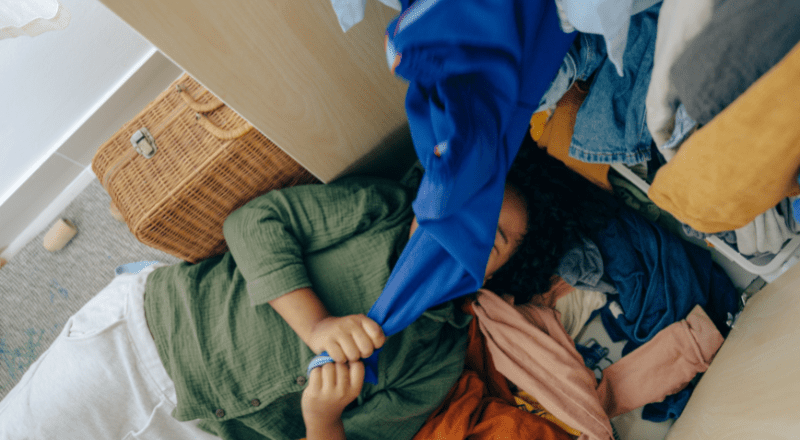
The clothes you wear say so much about your personality, your fashion sense, and your likes and dislikes. If clothes are important to you, you want to keep them fresh, clean, and well kept for as long as possible. Clothing storage is always an important aspect to consider when caring for your clothing. While closets and bureaus are the go-to locations for us to store our duds, they may not always be the best option. Let’s look at five smart ideas for storing your clothes in your home.
Dark & Dry Clothing Storage
When you are storing clothes, the two Ds are important to remember. It is important to keep clothes dry not only to preserve them, but also because excess moisture will encourage the growth of mold and mildew, which will give your garments an unpleasant musty smell. Keeping them in the dark prevents colors from fading. How do you keep clothes dry? Location is important, so places like garages, unfinished basements, or sheds are not ideal. Use a chemical desiccant such as calcium chloride or silica gel packets in the storage spot to absorb moisture. You can reuse the silica packets when they’ve absorbed a lot of moisture. Put them on a foil-lined tray and bake them at 300 degrees for a few minutes; when they cool they’re ready to go. Or fill a basket lined with plastic with charcoal and replace every two months. Running a fan on high regularly in the storage area will disperse and dry any moisture.
Breathe, baby, breathe!
Let fabrics breathe, particularly natural materials like cotton, linen, silk and wool. If clothing is stored too tightly, air cannot circulate, which can lead to mildew and mold. For the same reason, storing clothes in plastic bags or sealed airtight containers can harm the garments. One alternative is to use rattan trunks, which allow air to circulate. Don’t use starch or fabric finish on clothes that are going to be stored.
Get Creative With Clothing Storage Space
If you live in a smaller spot, or simply don’t have enough room, there are a number of hacks you can do to free up extra room. For one, portable garment racks are inexpensive and assemble in minutes. Instant, movable closet! Shelf dividers, adhesive wall hooks, stackable laundry baskets, trunks, wine racks, ladders. bathroom hardware, shower hooks, PVC piping, and even luggage pieces can provide extra storage without taking up additional space. Also think up and down. Particularly for off-season clothing, consider putting some of it in storage containers under or on top of your bed or adding additional shelves in the higher parts of your existing closets. You can also extend the space in your closet by using some hangar hacks. One clever idea is to use a soda can tab to hook two or three hangars together. Shoes can stay neat and tidy if you keep them in those perfectly rectangular boxes they come in. Affix a picture of the shoes to the box and suddenly that jumble on the closet floor is neat and tidy.
Keep Those Bugs Out
While moths are probably the bugs most closely associated with clothing damage, they are not the only culprit. Other flying and crawling pests can wreak havoc too. Carpet beetles are prolific, laying 100 or so eggs on carpet, furniture and clothing that hatch in 8-15 days. The larvae immediately begin feeding on fabrics, particularly wool, mohair, fur and feathers. Carefully applied insecticides and repeated vacuums of areas like baseboards and heating ducts are the best way to eradicate the beetle larva.
There are two types of moths that cause damage to clothing. Again the larvae are the culprits for clothing chaos. Moth balls or blocks that contain naphthalene will repel the moths, but be careful. The chemical will also discolor fabrics so care should be made to wrap the deterrents in paper to prevent contact with clothing. Cockroaches can cause all kinds of health and home problems and clothes are no exception. Roaches are attracted to body fluid stains, laundry starch, and food and beverage stains, and can eat away at fibers at is eats the other items. Its wastes can also stain clothes. Crickets act similarly by cutting clothes while they munch at stains and starch. Silverfish, firebrats and even termites can also congregate in areas where there is a natural-fiber food source.
Keep Your Storage Area Clean
Keeping your garments clean is am important step year round. Professional laundry services are by far the best choice. Garments should always be cleaned before they are stored to remove any stains, sweat, and dirt. After you’ve gotten your clothes out of storage, it is also important to have a professional laundry clean them to make sure they are clean, fresh and well pressed.
With a few creative and careful steps, you can keep all of your clothing – and yourself – looking great! Also, feel free to take a look at our published blog post to learn more about storage tips for summer clothes!